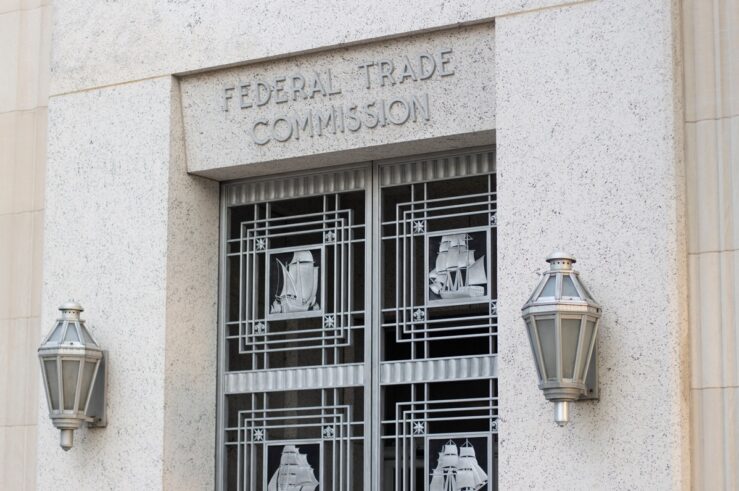
In an Agencies Roundup post several weeks ago, I revisited the Federal Trade Commission’s (FTC) newly adopted—and not-yet-effective—rule barring the use of noncompete agreements across much of the U.S. economy. It was not my first such post (my ninth, if I’ve counted correctly, and if readers will forgo armchair diagnoses of monomania). The last time around, I noted consolidated challenges to the rule being heard in the U.S. District Court for the Northern District of Texas, where Judge Ada Brown has said that she will issue a decision on the motion for a stay of the rule’s effective date by July 3.
A more patient person might wait for that decision before returning, for yet a tenth time, to issues raised by the FTC’s noncompete rule. A more delusional person might suppose a large readership poised to read a roundup on the eve of the Fourth of July holiday. Tradeoffs are ubiquitous.
And yet . . . there’s that pesky little matter of the U.S. Supreme Court’s recent decision in Loper Bright. In it, the Court held that its 1984 Chevron decision was overruled. The writing was on the wall already. As administrative law scholar Thomas Merrill put it in 2023, “[t]he Supreme Court seems to have lost all enthusiasm for deferring to agency interpretations of the law they administer.” Still, the wall is one thing, and a slip opinion from the nation’s high court is another. And things are moving: just today (July 2), the Court remanded nine cases “for further consideration in light of Loper Bright Enterprises v. Raimondo.”
Along with the Chevron decision goes the eponymous Chevron Doctrine, a central, if variably observed, pillar of administrative law. Chevron deference was never absolute, and its repudiation does not terminate judicial deference to agency determinations. Still, as Merrill and Kristin Hickman observed in 2001, Chevron “dramatically expanded the circumstances in which courts must defer to agency interpretations of statutes,” and that expansion has now been contracted in no uncertain terms. As Chief Justice John Roberts, writing for the majority, put it, courts should not “pretend that [statutory] ambiguities are necessarily delegations.” Hereinafter, “[c]ourts must exercise their independent judgment in deciding whether an agency has acted within its statutory authority.”
It’s not entirely clear where the ground of statutory ambiguity will settle in the wake of Loper Bright, but it is clear that the ground has shifted, and that cannot bode well for the FTC’s noncompete rule. West Virginia v EPA and the Major Questions Doctrine (MQD) aside (and that’s no small aside), the question whether the FTC has the authority to issue substantive or “legislative” competition regulations is a matter of some controversy.
There is a colorable argument to the effect that Section 6(g) of the FTC Act grants the agency such authority. It does stipulate some sort of authority to “make rules and regulations”; and it does not expressly limit such authority to rules of agency process, “interpretive rules,” or general statements of policy, such as guidance. It’s an argument that was endorsed by a panel of the U.S. Court of Appeals for the D.C. Circuit in its 1973 National Petroleum Refiners decision—a decision that is still, in some sense, “good law,” if not binding on any federal courts besides the U.S. District Court for the District of Columbia.
And yet, the FTC’s claim to authority is not so easy. For one, Judge Skelly Wright’s panel decision in National Petroleum Refiners depended on methods of statutory construction long since out of favor in reversing a decision of the district court below, which had held that “the FTC lacks the requisite statutory authority to issue Trade Regulations Rules.” Or, as administrative law scholar Richard Pierce put it:
the method of statutory interpretation that the D.C. Circuit used in National Petroleum Refiners has never been embraced by the Supreme Court; it has not been used by any court in decades; and, it is inconsistent with the principles of separation of powers that the Supreme Court has emphasized for decades
Of course, the circuit court had the authority to reverse the district court below, notwithstanding the lower court’s careful discussion of the statutory language, structure, and legislative history of the FTC Act. But that may be beside the point if other circuits, or the Supreme Court, read the statute differently now.
For the untutored but ambitious, there’s also an entire volume of mostly skeptical essays on the FTC’s authority edited by Daniel Crane, “Rulemaking Authority of the Federal Trade Commission.” Contributors to that volume include, among others, Crane himself, former FTC chairs Timothy Muris (with J. Howard Beales III) and Maureen Ohlhausen (once with Ben Rossen and once with former Assistant U.S. Attorney General for Antitrust James Rill), former FTC General Counsel Alden Abbott, and administrative-law scholars Richard Pierce and Jonathan Barnett, along with a pro-regulatory essay by Marina Lao. Separately, my International Center for Law & Economics (ICLE) colleague Gus Hurwitz recently published this piece in the George Mason Law Review, discussing the conditions under which the Court seemed “likely to close the door on administrative antitrust for reasons sounding in both administrative and antitrust law.”
Of course, National Petroleum Refiners did not depend on Chevron, which it preceded by more than a decade. Judge Wright’s opinion did, however, depend on a contested reading of the statutory history and original (1914) meaning of the FTC Act as “ambiguous.” And perhaps that explains why, in a 2020 paper in the University of Chicago Law Review (“The Case for ‘Unfair Methods of Competition’ Rulemaking”), then-Commissioner Rohit Chopra and now-FTC Chair Lina Khan argued that substantive competition rulemaking under the FTC Act “is governed by the Administrative Procedure Act and is eligible for Chevron deference.” Change the “is” to either “was” or “was previously supposed to be” and one begins to see the problem.
Chopra and Khan accept National Petroleum Refiners at face value, and indeed read the 1914 §6(g) provision through the lens of Chevron:
In order to equip the FTC to fulfill this institutional mission, Congress endowed the Commission with the authority to “make rules and regulations for the purpose of carrying out the [FTC Act’s] provisions.” In the parlance of Chevron, this means “Congress delegated authority to the agency generally to make rules carrying the force of law,” and agency interpretations made pursuant to that authority fall within the domain of Chevron.
In doing so, they breeze past the issues of statutory language, structure, and legislative history raised by the D.C. District Court in National Petroleum, as well as those considered in great detail in, among others, a 2002 article by Merrill and Kathryn Tongue Watts in the Harvard Law Review (“Agency Rules with the Force of Law: The Original Convention”), which argued that the D.C. Circuit misread a much more limited grant of rulemaking authority in 6(g). And the fact that such “rules with the force of law” would be made without any statutory penalty authority.
They cite briefly to the legislative history of the 1975 Magnusson-Moss Warranty Act and the 1980 FTC Improvements Act, which expressly granted the agency the authority to adopt trade-regulation rules under its “unfair or deceptive acts or practices” (UDAP) authority—that is, its general consumer-protection authority, albeit subject to additional procedural requirements besides those imposed by the APA. But in doing so, they elide, among other things, the House Report accompanying the House version of Magnusson-Moss—the version that included rulemaking authority for consumer-protection matters, which was maintained by the conference committee—which included the following:
Section 202 replaces the existing rulemaking authority of the FTC under section 6(g) of the Act with a new section 18 which authorizes the FTC to issue rules defining with specificity the acts or practices which are unfair or deceptive and which are within the scope of section 5(a)(1) of the Federal Trade Commission Act . . . . This rulemaking authority would be the exclusive substantive rulemaking authority of the FTC under the Federal Trade Commission Act. Thus, the Commission would not have rulemaking authority with respect to unfair methods of competition to the extent they are not unfair for deceptive acts or practices.
There is, of course, the savings clause of Section 18:
The preceding sentence shall not affect any authority of the Commission to prescribe rules (including interpretive rules), and general statements of policy, with respect to unfair methods of competition in or affecting commerce.
One can argue that the savings clause does not expressly disclaim substantive rulemaking authority. But then, it doesn’t include it either, while it does include “interpretive rules” and “general statements of policy,” such as the merger guidelines. Ejustent generis and all that.
At least two other issues need mention. Whatever the Court might make of Section 6(g) as a general matter, there remains the question whether the FTC has the authority to adopt the particular rule it did.
First, the FTC’s final rule and NPRM both anticipated challenges based on the MQD and declared, summarily, that “the Commission concludes that the final rule does not implicate the major questions doctrine”; at the same time, the FTC seems to have drafted the prologue to the rule, as well as accompanying statements, in a manner begging for MQD review. As the Court said in West Virginia:
Precedent teaches that there are “extraordinary cases” in which the “history and the breadth of the authority that [the agency] has asserted,” and the “economic and political significance” of that assertion, provide a “reason to hesitate before concluding that Congress” meant to confer such authority.
And as noted in West Virginia and in Utility Air, courts “expect Congress to speak clearly if it wishes to assign to an agency decisions of vast economic and political significance.”
Novel assertions of authority may be especially suspect, yet it’s not clear that the FTC has ever enforced a competition regulation (or tried a noncompete matter in federal court under Section 5, even if it settled several matters, by consent, a whole day before it issued the noncompete notice of proposed rulemaking). The Octane Rule that led to the National Petroleum decision was nominally both a consumer-protection and a competition rule, but that is a fuel-labeling rule, unrecognizable as anything sounding in antitrust, and since maintained under distinct statutory authority. The ineffectual Tailored Clothing Rule, adopted in 1968, was nominally a UMC rule too; and it was on the books until rescinded in 1994. But it was never enforced, and it, too, seems hard to reconcile with anything sounding in antitrust. So . . . somewhere between extremely novel and entirely novel?
Meanwhile, the FTC “estimates that approximately one in five American workers—or approximately 30 million workers—is subject to a non-compete”; and it estimates “substantial positive effects of the proposed rule” to include, among others, “an increase in workers’ earnings by $250-$296 billion annually.” The estimate may be dubious (ok, it’s entirely dubious). Still, all the hallmarks of a major question are there, while we might search in vain for any statutory suggestion that the FTC regulates labor matters.
Second, while the commission itself claims “that Congress provided clear authorization for the Commission to promulgate this rule” in the entirely general grant of authority in 6(g), its construction begs credulity. In West Virginia, the Court repudiated the Environmental Protection Agency’s comparatively narrow claim to authority, observing that “[s]uch a vague statutory grant is not close to the sort of clear authorization required by our precedents.” In that matter, there was no dispute that the EPA had some form of regulatory authority for power-plant emissions; the question had to do with the scope of its authority. The FTC argues that Section 6(g) clearly gives it the authority to adopt legislative rules prohibiting what it deems to be violations of Section 5’s prohibition of “unfair methods of competition.” Question: what are those?
Recall that, in November 2022 the FTC issued a new policy statement regarding unfair methods of competition under Section 5, which was, as Gus Hurwitz and I put it, “Untethered from Consumer Welfare and the Rule of Reason.” In it, the commission expressly repudiated those established standards and, indeed, the constraint of actual or even likely harm to competition in favor of a “tendency” (not necessarily a likelihood) to “negatively affect” (perhaps harm, who knows?) “competitive conditions.” Net effects? Out the window, along with efficiencies. Quantitative assessments? Unnecessary. What could be vaguer? Seriously.
What was in the policy statement, besides the kitchen sink, was a regulatory agenda for competition. One might have batted for a single in one’s first trip to the plate. Maybe they’ll hit a home run, but the betting money says that they’ll go down swinging.




